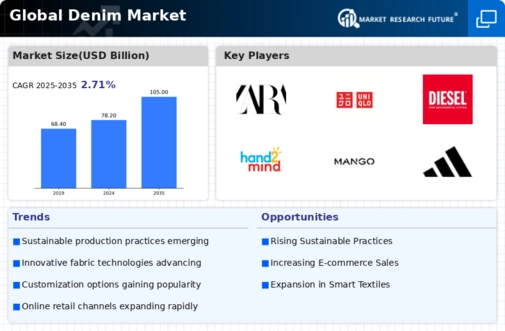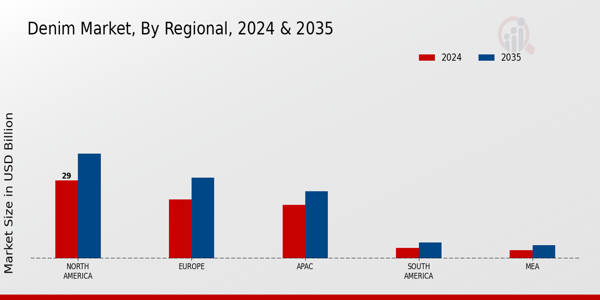- Denim Market By Fabric Type (USD Billion, 2019-2035)
- Cotton Denim
- Stretch Denim
- Recycled Denim
- Organic Denim
- Denim Market By Product Type (USD Billion, 2019-2035)
- Denim Market By End Use (USD Billion, 2019-2035)
- Denim Market By Distribution Channel (USD Billion, 2019-2035)
- Online
- Offline
- Department Stores
- Denim Market By Regional (USD Billion, 2019-2035)
- North America
- Europe
- South America
- Asia Pacific
- Middle East and Africa
North America Outlook (USD Billion, 2019-2035)
North America Denim Market by Fabric Type
Cotton Denim
Stretch Denim
Recycled Denim
Organic Denim
North America Denim Market by Product Type
Jeans
Jackets
Shirts
Skirts
North America Denim Market by End Use Type
Men
Women
Kids
North America Denim Market by Distribution Channel Type
Online
Offline
Department Stores
North America Denim Market by Regional Type
US
Canada
US Outlook (USD Billion, 2019-2035)
US Denim Market by Fabric Type
Cotton Denim
Stretch Denim
Recycled Denim
Organic Denim
US Denim Market by Product Type
Jeans
Jackets
Shirts
Skirts
US Denim Market by End Use Type
Men
Women
Kids
US Denim Market by Distribution Channel Type
Online
Offline
Department Stores
CANADA Outlook (USD Billion, 2019-2035)
CANADA Denim Market by Fabric Type
Cotton Denim
Stretch Denim
Recycled Denim
Organic Denim
CANADA Denim Market by Product Type
Jeans
Jackets
Shirts
Skirts
CANADA Denim Market by End Use Type
Men
Women
Kids
CANADA Denim Market by Distribution Channel Type
Online
Offline
Department Stores
Europe Outlook (USD Billion, 2019-2035)
Europe Denim Market by Fabric Type
Cotton Denim
Stretch Denim
Recycled Denim
Organic Denim
Europe Denim Market by Product Type
Jeans
Jackets
Shirts
Skirts
Europe Denim Market by End Use Type
Men
Women
Kids
Europe Denim Market by Distribution Channel Type
Online
Offline
Department Stores
Europe Denim Market by Regional Type
Germany
UK
France
Russia
Italy
Spain
Rest of Europe
GERMANY Outlook (USD Billion, 2019-2035)
GERMANY Denim Market by Fabric Type
Cotton Denim
Stretch Denim
Recycled Denim
Organic Denim
GERMANY Denim Market by Product Type
Jeans
Jackets
Shirts
Skirts
GERMANY Denim Market by End Use Type
Men
Women
Kids
GERMANY Denim Market by Distribution Channel Type
Online
Offline
Department Stores
UK Outlook (USD Billion, 2019-2035)
UK Denim Market by Fabric Type
Cotton Denim
Stretch Denim
Recycled Denim
Organic Denim
UK Denim Market by Product Type
Jeans
Jackets
Shirts
Skirts
UK Denim Market by End Use Type
Men
Women
Kids
UK Denim Market by Distribution Channel Type
Online
Offline
Department Stores
FRANCE Outlook (USD Billion, 2019-2035)
FRANCE Denim Market by Fabric Type
Cotton Denim
Stretch Denim
Recycled Denim
Organic Denim
FRANCE Denim Market by Product Type
Jeans
Jackets
Shirts
Skirts
FRANCE Denim Market by End Use Type
Men
Women
Kids
FRANCE Denim Market by Distribution Channel Type
Online
Offline
Department Stores
RUSSIA Outlook (USD Billion, 2019-2035)
RUSSIA Denim Market by Fabric Type
Cotton Denim
Stretch Denim
Recycled Denim
Organic Denim
RUSSIA Denim Market by Product Type
Jeans
Jackets
Shirts
Skirts
RUSSIA Denim Market by End Use Type
Men
Women
Kids
RUSSIA Denim Market by Distribution Channel Type
Online
Offline
Department Stores
ITALY Outlook (USD Billion, 2019-2035)
ITALY Denim Market by Fabric Type
Cotton Denim
Stretch Denim
Recycled Denim
Organic Denim
ITALY Denim Market by Product Type
Jeans
Jackets
Shirts
Skirts
ITALY Denim Market by End Use Type
Men
Women
Kids
ITALY Denim Market by Distribution Channel Type
Online
Offline
Department Stores
SPAIN Outlook (USD Billion, 2019-2035)
SPAIN Denim Market by Fabric Type
Cotton Denim
Stretch Denim
Recycled Denim
Organic Denim
SPAIN Denim Market by Product Type
Jeans
Jackets
Shirts
Skirts
SPAIN Denim Market by End Use Type
Men
Women
Kids
SPAIN Denim Market by Distribution Channel Type
Online
Offline
Department Stores
REST OF EUROPE Outlook (USD Billion, 2019-2035)
REST OF EUROPE Denim Market by Fabric Type
Cotton Denim
Stretch Denim
Recycled Denim
Organic Denim
REST OF EUROPE Denim Market by Product Type
Jeans
Jackets
Shirts
Skirts
REST OF EUROPE Denim Market by End Use Type
Men
Women
Kids
REST OF EUROPE Denim Market by Distribution Channel Type
Online
Offline
Department Stores
APAC Outlook (USD Billion, 2019-2035)
APAC Denim Market by Fabric Type
Cotton Denim
Stretch Denim
Recycled Denim
Organic Denim
APAC Denim Market by Product Type
Jeans
Jackets
Shirts
Skirts
APAC Denim Market by End Use Type
Men
Women
Kids
APAC Denim Market by Distribution Channel Type
Online
Offline
Department Stores
APAC Denim Market by Regional Type
China
India
Japan
South Korea
Malaysia
Thailand
Indonesia
Rest of APAC
CHINA Outlook (USD Billion, 2019-2035)
CHINA Denim Market by Fabric Type
Cotton Denim
Stretch Denim
Recycled Denim
Organic Denim
CHINA Denim Market by Product Type
Jeans
Jackets
Shirts
Skirts
CHINA Denim Market by End Use Type
Men
Women
Kids
CHINA Denim Market by Distribution Channel Type
Online
Offline
Department Stores
INDIA Outlook (USD Billion, 2019-2035)
INDIA Denim Market by Fabric Type
Cotton Denim
Stretch Denim
Recycled Denim
Organic Denim
INDIA Denim Market by Product Type
Jeans
Jackets
Shirts
Skirts
INDIA Denim Market by End Use Type
Men
Women
Kids
INDIA Denim Market by Distribution Channel Type
Online
Offline
Department Stores
JAPAN Outlook (USD Billion, 2019-2035)
JAPAN Denim Market by Fabric Type
Cotton Denim
Stretch Denim
Recycled Denim
Organic Denim
JAPAN Denim Market by Product Type
Jeans
Jackets
Shirts
Skirts
JAPAN Denim Market by End Use Type
Men
Women
Kids
JAPAN Denim Market by Distribution Channel Type
Online
Offline
Department Stores
SOUTH KOREA Outlook (USD Billion, 2019-2035)
SOUTH KOREA Denim Market by Fabric Type
Cotton Denim
Stretch Denim
Recycled Denim
Organic Denim
SOUTH KOREA Denim Market by Product Type
Jeans
Jackets
Shirts
Skirts
SOUTH KOREA Denim Market by End Use Type
Men
Women
Kids
SOUTH KOREA Denim Market by Distribution Channel Type
Online
Offline
Department Stores
MALAYSIA Outlook (USD Billion, 2019-2035)
MALAYSIA Denim Market by Fabric Type
Cotton Denim
Stretch Denim
Recycled Denim
Organic Denim
MALAYSIA Denim Market by Product Type
Jeans
Jackets
Shirts
Skirts
MALAYSIA Denim Market by End Use Type
Men
Women
Kids
MALAYSIA Denim Market by Distribution Channel Type
Online
Offline
Department Stores
THAILAND Outlook (USD Billion, 2019-2035)
THAILAND Denim Market by Fabric Type
Cotton Denim
Stretch Denim
Recycled Denim
Organic Denim
THAILAND Denim Market by Product Type
Jeans
Jackets
Shirts
Skirts
THAILAND Denim Market by End Use Type
Men
Women
Kids
THAILAND Denim Market by Distribution Channel Type
Online
Offline
Department Stores
INDONESIA Outlook (USD Billion, 2019-2035)
INDONESIA Denim Market by Fabric Type
Cotton Denim
Stretch Denim
Recycled Denim
Organic Denim
INDONESIA Denim Market by Product Type
Jeans
Jackets
Shirts
Skirts
INDONESIA Denim Market by End Use Type
Men
Women
Kids
INDONESIA Denim Market by Distribution Channel Type
Online
Offline
Department Stores
REST OF APAC Outlook (USD Billion, 2019-2035)
REST OF APAC Denim Market by Fabric Type
Cotton Denim
Stretch Denim
Recycled Denim
Organic Denim
REST OF APAC Denim Market by Product Type
Jeans
Jackets
Shirts
Skirts
REST OF APAC Denim Market by End Use Type
Men
Women
Kids
REST OF APAC Denim Market by Distribution Channel Type
Online
Offline
Department Stores
South America Outlook (USD Billion, 2019-2035)
South America Denim Market by Fabric Type
Cotton Denim
Stretch Denim
Recycled Denim
Organic Denim
South America Denim Market by Product Type
Jeans
Jackets
Shirts
Skirts
South America Denim Market by End Use Type
Men
Women
Kids
South America Denim Market by Distribution Channel Type
Online
Offline
Department Stores
South America Denim Market by Regional Type
Brazil
Mexico
Argentina
Rest of South America
BRAZIL Outlook (USD Billion, 2019-2035)
BRAZIL Denim Market by Fabric Type
Cotton Denim
Stretch Denim
Recycled Denim
Organic Denim
BRAZIL Denim Market by Product Type
Jeans
Jackets
Shirts
Skirts
BRAZIL Denim Market by End Use Type
Men
Women
Kids
BRAZIL Denim Market by Distribution Channel Type
Online
Offline
Department Stores
MEXICO Outlook (USD Billion, 2019-2035)
MEXICO Denim Market by Fabric Type
Cotton Denim
Stretch Denim
Recycled Denim
Organic Denim
MEXICO Denim Market by Product Type
Jeans
Jackets
Shirts
Skirts
MEXICO Denim Market by End Use Type
Men
Women
Kids
MEXICO Denim Market by Distribution Channel Type
Online
Offline
Department Stores
ARGENTINA Outlook (USD Billion, 2019-2035)
ARGENTINA Denim Market by Fabric Type
Cotton Denim
Stretch Denim
Recycled Denim
Organic Denim
ARGENTINA Denim Market by Product Type
Jeans
Jackets
Shirts
Skirts
ARGENTINA Denim Market by End Use Type
Men
Women
Kids
ARGENTINA Denim Market by Distribution Channel Type
Online
Offline
Department Stores
REST OF SOUTH AMERICA Outlook (USD Billion, 2019-2035)
REST OF SOUTH AMERICA Denim Market by Fabric Type
Cotton Denim
Stretch Denim
Recycled Denim
Organic Denim
REST OF SOUTH AMERICA Denim Market by Product Type
Jeans
Jackets
Shirts
Skirts
REST OF SOUTH AMERICA Denim Market by End Use Type
Men
Women
Kids
REST OF SOUTH AMERICA Denim Market by Distribution Channel Type
Online
Offline
Department Stores
MEA Outlook (USD Billion, 2019-2035)
MEA Denim Market by Fabric Type
Cotton Denim
Stretch Denim
Recycled Denim
Organic Denim
MEA Denim Market by Product Type
Jeans
Jackets
Shirts
Skirts
MEA Denim Market by End Use Type
Men
Women
Kids
MEA Denim Market by Distribution Channel Type
Online
Offline
Department Stores
MEA Denim Market by Regional Type
GCC Countries
South Africa
Rest of MEA
GCC COUNTRIES Outlook (USD Billion, 2019-2035)
GCC COUNTRIES Denim Market by Fabric Type
Cotton Denim
Stretch Denim
Recycled Denim
Organic Denim
GCC COUNTRIES Denim Market by Product Type
Jeans
Jackets
Shirts
Skirts
GCC COUNTRIES Denim Market by End Use Type
Men
Women
Kids
GCC COUNTRIES Denim Market by Distribution Channel Type
Online
Offline
Department Stores
SOUTH AFRICA Outlook (USD Billion, 2019-2035)
SOUTH AFRICA Denim Market by Fabric Type
Cotton Denim
Stretch Denim
Recycled Denim
Organic Denim
SOUTH AFRICA Denim Market by Product Type
Jeans
Jackets
Shirts
Skirts
SOUTH AFRICA Denim Market by End Use Type
Men
Women
Kids
SOUTH AFRICA Denim Market by Distribution Channel Type
Online
Offline
Department Stores
REST OF MEA Outlook (USD Billion, 2019-2035)
REST OF MEA Denim Market by Fabric Type
Cotton Denim
Stretch Denim
Recycled Denim
Organic Denim
REST OF MEA Denim Market by Product Type
Jeans
Jackets
Shirts
Skirts
REST OF MEA Denim Market by End Use Type
Men
Women
Kids
REST OF MEA Denim Market by Distribution Channel Type
Online
Offline
Department Stores

















Leave a Comment